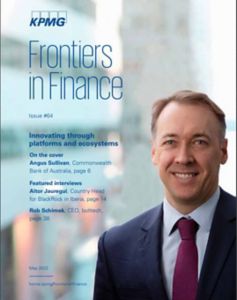The proliferation and popularity of cryptoassets continue to generate widespread interest – and considerable debate – over what the future holds for today’s fast-emerging digital economy and the global financial services.
The cryptocurrency trend that has soared in the wake of Bitcoin’s emergence offers an array of potential benefits for users and holds the potential to revolutionize the global financial ecosystem. But significant challenges remain for cryptocurrencies and without institutionalization — large-scale participation by emerging and traditional financial-services companies — crypto’s prospects for success remain limited if not uncertain.
Cryptoassets are digital assets that use cryptography, a peerto-peer network, and a public/private ledger to create, trade and manage those assets. The current array of cryptoassets includes cryptocurrencies, protocol tokens, stablecoins, security tokens, and non-fungible tokens (NFTs). Their value to users is diverse — whether as an investment asset class, a store of value, a medium of exchange, or a record of rights and ownership. Their emergence has been largely driven by retail demand and financial institutions are increasingly offering cryptoasset services to meet their clients’ demands and expectations in areas such as research, trading and custody.
Seen for their potential to revolutionize the financial sector and create an open global financial system, their benefits include: reducing friction, inefficiencies and costs within today’s the global financial system; a hedge against currency devaluation and hyperinflation; providing access to the unbanked; and a peer-to-peer exchange/trading capability providing access to investment opportunities for a larger population. Some specific cryptocurrency products, services and use cases include:
- Bitcoin as an emerging digital asset class, similar to gold and seen as an alternative to traditional asset classes.
- Ethereum (ETH) and its enablement of initial coin offerings (ICOs) to raise capital and encourage a broader flow of capital from a wider group of investors. Ethereum is a decentralized, open-source blockchain and ETH is the leading protocol token for decentralized finance (DeFi) applications. Most of today’s top 10 DeFi solutions by market capitalization are built on the Ethereum blockchain.
- Litecoin and its ability to enhance the speed, accessibility and cost of current cross-border payment systems such as wire transfers
- Tokenization involving the creation of digital, tokenized versions of traditional assets such as securities, commodities and real estate assets. The tokenized economy is being seen as a particularly significant innovation that crypto is enabling.
As they continue to gain attention and adoption, consider some of the numbers related to the soaring crypto market today:
- The cryptocurrency market soared to an all-time high of US$3 billion in November 2021, but has subsequently dropped to around US$2 billion, as of April 2022. Two of the world’s largest cryptocurrencies — Bitcoin and Ether, the token supporting the Ethereum DLT — also surged to record highs in November 2021.1
- There were more than 10,000 cryptocurrencies in existence as of November 2021.2
- The global cryptoasset-management market is projected to grow from US$0.4 billion in 2021 to US$1.2 billion by 2026, reflecting a compound annual growth rate of 21.5 percent.3
Nations leading the way in crypto adoption include the US, India, Vietnam, Pakistan, El Salvador, Nigeria, Canada and Singapore. El Salvador, for example, has adopted Bitcoin as legal currency, and Nigeria recently launched the ‘eNaira,’ a central bank digital currency that is the first in Africa. The ASPAC region is anticipated to be the fastest-growing market in the next few years amid emerging network infrastructure, continued economic growth, the emergence of affluent young investors, and a relatively stable geopolitical system, all of which are providing a fertile ecosystem for crypto services.
Challenges amid revolutionary opportunities
While the promise of cryptoassets to redefine the global financial ecosystem is clear, so are the current significant challenges they face. It is important to note that cryptoassets do not fulfil the primary functions of money as a medium of exchange, a unit of account and a store of value, and they are not deemed a viable substitute for cash and deposits. Cash is still king — at least for the time being.
A global regulatory framework for cryptoassets has yet to emerge amid today’s patchwork of regulatory guidelines, and regulators are focusing on establishing essential requirements for participants in the crypto space. The regulatory focus largely to date has been on antimoney laundering (AML), know-yourcustomer (KYC) requirements and regulatory permissions regimes. KYC considerations are a high priority, given that cryptoasset owners are ‘identified’ using cryptographic addresses that pose barriers to knowing exactly who owns what in today’s crypto ecosystem. Establishing a KYC program that can verify customers and risk profiles, monitor transactions and help ensure anti-money laundering (AML) capabilities will be crucial.
Tax implications, accounting and financial reporting will also demand solutions. Accounting for cryptoassets remains an emerging area that poses challenges amid traditional reporting requirements and limited guidance to date. On the tax front, guidance also remains inadequate regarding tax treatment of cryptoassets and potential liabilities related to their sale or exchange.
Not to be underestimated is the need for broad accessibility that can also ensure appropriate security and protection from cyber criminals targeting cryptoassets. Security and trust are paramount for cryptoassets, as their potential for cybercrime is known to be high today. See article, Tax information reporting on cryptoassets.
Regulators are responding
On the regulatory front, the Basel Committee on Banking Supervision (BCBS) is considering how the Basel Framework should incorporate cryptoassets.4 The BCBS stated its minimum expectations for banks’ exposures to cryptoassets and related services in March 2019, and
these expectations may be further augmented by additional country-specific requirements. They apply to due diligence regarding:
- risk assessment
- governance and risk management via a robust framework
- public disclosure of cryptoasset exposures and their accounting treatment
- supervisory dialogue to inform authorities of crypto activity, exposures and due diligence in a timely manner.
In October 2021, meanwhile, the Financial Action Task Force (FATF), as part of its ongoing global monitoring of virtual assets, came out with its Updated Guidance for a Risk-Based Approach to Virtual Assets and Virtual Asset Service Providers.5 The guidance from the FATF -the global money-laundering and terrorist-financing watchdog — includes updates focusing on six key areas:
1. clarification of the definitions of virtual assets and providers
2. guidance on how FATF standards apply to stablecoins
3. additional guidance on the risks and tools available to countries to address money-laundering and terrorist-financing risks for peer-to-peer transactions — updated guidance on the licensing and registration of service providers
4. updated guidance on the licensing and registration of service providers
5. additional guidance for the public and private sectors on implementation of the ‘travel rule’ requiring businesses to collect and share personal data of participants in a transaction
6. principles for information-sharing and co-operation among service provider supervisors.
The need for fork management and governance is also significant. Forks that occur when a single blockchain breaks into two chains will likely require financial businesses to manage this capability from an array of perspectives that include technology, operations, accounting and tax implications.
The KPMG Cryptoasset Framework
As the future of cryptoassets continues to emerge, the KPMG Cryptoasset Framework is being used by our firms’ crypto specialists to provide businesses with the key capabilities they need related to strategy, technology, operations, cybersecurity, risk management and compliance. Our framework addresses these crucial capabilities across five pillars:
Plan: Strategizing on the products and services to be provided and establishing an optimal product-market fit.
Onboard: Onboarding the cryptoasset and the customer.
Service and delivery: Providing support for cryptoasset servicing and management.
Protect: Securing cryptoassets, protecting client confidentiality, monitoring blockchains.
Comply and report: Complying with applicable regulatory frameworks, financial reporting requirements and tax-reporting obligations.
Leveraging the KPMG Cryptoassets Framework, our risk-assessment work with one large financial institution identified more than 200 risks related to crypto that the organization will need to address. And within those risks exist several hundred more factors demanding solutions. With cryptoassets being developed by third parties, for example, banks will need to closely address third-party and vendor risks.
Ultimately, it seems clear that amid their potential, the success of cryptoassets and their markets will depend on addressing key challenges such as regulatory compliance, price volatility, liquidity and security. Institutional participation by banks, broker dealers, exchanges, payment services, fintechs and other players in today’s financial ecosystem will inspire confidence in these emerging products and markets.
As cryptoassets increasingly go mainstream among financial institutions, dedicated crypto services and products will continue to emerge, ultimately enhancing opportunities to manage cryptoassets while raising awareness of their potential benefits among investors and the public. Institutional-grade infrastructure and services can ultimately position cryptoassets to deliver on their potential.
Connect with us
- Find office locations kpmg.findOfficeLocations
- kpmg.emailUs
- Social media @ KPMG kpmg.socialMedia
Explore more chapters
Explore
1 https://fortune.com/2021/11/09/cryptocurrency-market-cap-3-trillion-bitcion-ether-shiba-inu/
2 https://www.investopedia.com/tech/most-important-cryptocurrencies-other-than-bitcoin/
3 Crypto Asset Management market, 2021
4 https://home.kpmg/ca/en/home/insights/2020/03/beyond-basel-iv-crypto-assets-and-basel-framework.html
5 https://www.fatf-gafi.org/publications/fatfrecommendations/documents/guidance-rba-virtual-assets-2021.html







